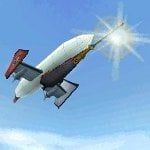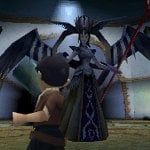
Nostalgia's title is not an indication of the game's plot but rather a mission statement. It's a tribute to the old 16-bit Japanese RPG's like Final Fantasy VI and Chrono Trigger that genre fans still worship to this day. Every aspect of Nostalgia demonstrates the developers' reverence for these old classics but little effort is made to improve upon their well-worn gameplay formula.
Co-developer Matrix Software was actually responsible for the DS ports of Final Fantasy III and Final Fantasy IV so the graphics will look familiar to anyone who has played those. The characters are 3D and drawn in anime style, with spikey hair and too-large eyes. The environments are three-dimensional as well but unfortunately you can't rotate them. Often you'll get stuck trying to find a door on the bottom or left of the screen. There's a tendency in some RPG's to simply use the same tilesets over and over for towns but the various cities of Nostalgia and their inhabitants have a distinct look.
For reasons unclear to me, Red Entertainment and Matrix Software decided to use the real world as the setting for Nostalgia. It allows them to include cities like London and Tokyo and historical ruins such as the Egyptian pyramids and Easter Island but they're really just set pieces. The game doesn't draw upon real world history or politics for plot inspiration at all. I'm not even sure what time period it's supposed to be set in, as Nostalgia's world contains airships, robots, machine guns, and swords. Regardless of what era we're in, there had to be something interesting going on in the world but no one ever mentions it. The world just feels like a scattered group of isolated cities and dungeons. Change the city names, scramble the world map and remove a few shots of historical landmarks and no one would ever guess this was supposed to be Earth. It doesn't make any sense to use the real world as a setting but then to only use an ounce of its potential.

Nostalgia's Earth doesn't feel anything like the actual Earth but that wouldn't have been so bad if the game had presented an interesting twist on the real world but that isn't the case here. The game stars four kids who go on a quest to save the world from a secret society trying to rule the world. Their plans for world dominance require them to gather seven magical tablets from the corners of the world. Our heroes decide that the only way to stop their plan is to gather the tablets themselves and hope that the villains don't just steal them as soon as they've got all seven. In other words, it's the same plot of at least half of the RPG's you've played. Eventually the story gets a little interesting but the twists occur too late in the game
The four main characters don't help the plot any. The developers try to flesh them out a little by giving each a personal quest to fulfill over the course of the game but they're such tired ideas. To give a couple examples: Fiona has amnesia and Melody's trying to get revenge on a villain who killed her parent. They're teenagers but have the dispositions of six years olds so all of their interactions have an irritatingly cute tone. Every time one character is feeling sad (about their dead parent, amnesia, or whatever), another goes "Well, at least we've got each other!" and they instantly perk up. There are two boys and two girls in the party and early on it's quite clear they're going to couple up but again, they're children emotionally so these relationships feel like playground crushes more than anything.
In battle, the four characters fit neatly into player classes from the first Final Fantasy (Warrior, Thief, Black Mage, White Mage). This is fitting because the combat system in general feels the same as the old FF games. Battles are turn-based and begun by random encounter, which means that you don't see enemies that you're about to battle but are instead pulled into combat at random while walking through dungeons. Each character is able to attack with their weapon, perform a skill (abilities and spells that require magic points), defense, use an item, or run. The order in which characters get to act is displayed on the lower screen of the DS, next to their hit points and mana points. The basic structure of combat and the clean interface makes the learning curve almost non-existent for vets. The game's also very accessible to newcomers; the campaign is fairly easy and you're assisted by a guest NPC in battle for many portions of it.

The fact that there are only four playable characters and you can have all of them in your party at once means that you never have to worry about the make-up of your party. This robs players of a common strategic concern of most RPG's. Perhaps to compensate, Nostalgia allows you to have control over your characters' skill advancement. Each battle earns you skill points to beef up players' abilities and once a skill is sufficiently upgraded, another skill will be unlocked. A flow-chart shows which skills need to be advanced to unlock another skill but unfortunately they don't actually tell you what the unlockable skill is. These new skills just show up as a box with a question mark on the old flow-chart so you're kind of gambling with your skill points. There's usually some limited relationship between a skill and the next skill it unlocks (for example, upgrading a healing spell might get you a group healing spell) but that's not always the case. It's annoying to spend gobs of skill points only to receive a crap spell, which are plentiful in the game. Also, skillpoints earned by the party are all stored in one pool so you're squandering possible upgrades for other characters by pursuing these mystery skills. The shared skillpoint reservoir makes it quite easy to neglect certain characters but, considering it's one of the few strategic aspects of the game, it's a tolerable problem.
CINEMABLEND NEWSLETTER
Your Daily Blend of Entertainment News
Each character has two sets of skills: a set that he can use on the ground and a set he can use in the air. The party gets their own airship very early on in the game and partake in many air battles. These encounters are turn-based just like dungeon fights but each character now controls a different weapon on the airship (cannon, side guns, etc.) and that's what they use when you select the "Attack" option. The airship, rather than individual characters, takes damage throughout the fight. Weapons and armor for your ship are purchased and equipped at airship docks throughout the world.
From that description, you might think airship combat is just a slightly tweaked version of the game's normal ground combat. You'd be right. The character's airship-specific skills are less numerous than their ground skills and the enemies seem to have an excessive amount of hit points so these aerial encounters get repetitive quickly. The game makes a couple attempts to spice up this aspect of the game but to no avail. There's a weather system but these different conditions merely weaken your weapons (example: cannons are less powerful in rain) so it makes the fights even more drawn out. Your weapons perform differently based on whether enemies are in front of you or on your side but you can't control your position - enemies just zoom around to different spots at random - so it doesn't really change your strategy for the fight. It might affect which enemy you shoot first but that's about it.

The game's emphasis on airships ultimately does more harm than good. The separate equipment and skills needed for fighting in the air drains your budget of skillpoints and money on a continual basis. The game keeps you from higher-level areas with medium and tall mountain ranges, which you can't pass over until you get new flight engines through the campaign missions. The net result is that most of the world map is covered in ugly brown and green mountains. Once you're able to fly at max altitude, though, you probably won't most of the time because the enemies encountered up there are often absurdly difficult. There's a couple types of monsters that I just learned weren't worth fighting - I'd reset my DS and just reload rather than attempt them. The length and difficulty of the airship encounters ultimately discourages you from exploring the world map.
It's a shame that traveling the world is such a hassle because there's a lot of optional content in the game. There are 50 "World Treasures" (ancient ruins and such) throughout the map that can be spotted from your airship. Finding all of them earns you a hefty multiplier for your experience point gains. There are also a number of quests and dungeons for you to find. Each city contains a chapter of the Adventurer's Association, an organization that doles out quests to heroes who need money or have some time to kill. While some of these quests take you to new locations, many of them ask you to go back to a dungeon you've already completed. There are some handsome rewards doled out for these quests but doing the same dungeon twice might be a little too tedious for most of you.
Nostalgia sticks closely to the old JRPG formula and its few attempts at revamping this gameplay model are underwhelming. Still, it was fun enough to keep me playing until the end. Call it entertainment by association - playing Nostalgia conjured up fond memories of the first RPG's I ever played. I enjoyed the trip down memory lane but the truth is, Nostalgia isn't very good without the, well, nostalgia. It stubbornly clings to gameplay conventions over a decade old. I'm not sure if I'll ever look at it as anything more than a reminder of older, better games.
Players: 1 Player
Platform(s): DS
Developer: Matrix Software, Red Entertainment
Publisher: Ignition Entertainment
ESRB: Everyone
Rating:

Staff Writer at CinemaBlend.

After FBI: International Dropped A Devastating Reveal On Smitty Before Another Cast Change, Eva-Jane Willis Shared Why It Was 'Like Christmas'

Blood Of Zeus' Elias Toufexis Explains Season 2’s Long Delay And What Fans Need To Do To Ensure Season 3 Arrives Faster

As Chicago Med's Goodwin Has A Tough Decision To Make, How Worried Should We Be About Her Health Ahead Of The Finale?
Most Popular





